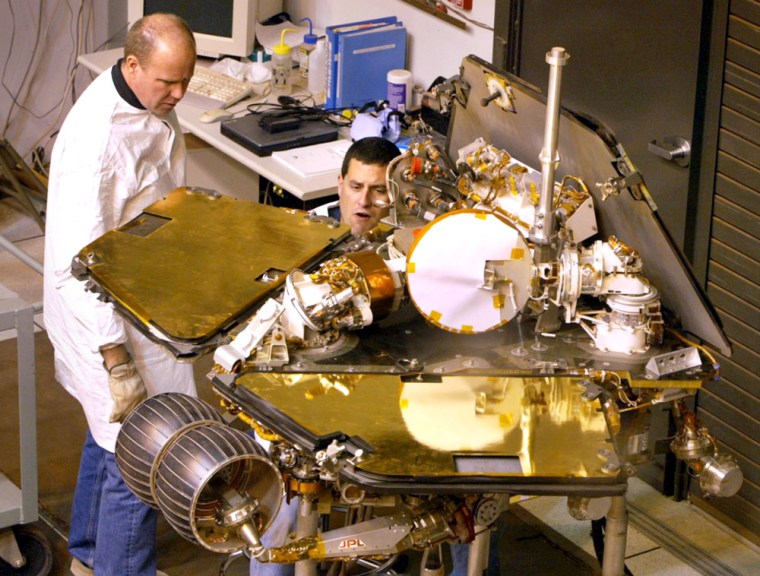Like a couple of camera-packing tourists, two robotic rovers are schlepping enough photographic gear to Mars to keep the folks back home in pictures for years.
NASA hopes the first of its twin rovers, Spirit, will begin taking pictures within hours of its landing Saturday. Its sibling, Opportunity, should do the same after its arrival at the Red Planet three weeks later.
During each of the 90-day missions, the remote-controlled shutterbugs could snap tens of thousands of photographs. The images, from the microscopic to the panoramic, should reveal the planet with unprecedented clarity.
Each six-wheeled robot, about the size of a golf cart, carries a suite of nine cameras, including a stereo pair with the equivalent of 20/20 vision.
Eyes on Mars
“These cameras will show what Mars would look like to your own eyes,” said Steve Squyres, chief scientist on the $820 million double mission.
Success is not guaranteed: Nearly two-thirds of the 36 missions sent to the surface of Mars have ended in failure. The latest, apparently, is the British Beagle 2 lander, which has not been heard from since it was to have set down on Mars last week.
NASA, which last lost a Mars lander of its own in 1999, stepped up oversight of how it designs, builds, launches and operates its spacecraft to boost the chances of success this time.
The agency is relying on rockets, parachutes and air bags to cushion the landing of the rovers. Once the rovers begin taking pictures and transmitting them, NASA’s Jet Propulsion Laboratory intends to post most of the images on the Web as soon as they are received on Earth.
“We’ll be sitting there at the Jet Propulsion Laboratory scratching our heads like everyone else,” said Jim Bell, lead scientist for the panoramic camera each rover carries.
Rocks below, sky above
Scientists plan to focus on rocks strewn across the Martian landscape that could reveal clues about whether the planet was ever hospitable to life.
They also plan to photograph the sun as it rises and sets on Mars, as well as Earth, which appears in the sky above the Red Planet as a morning star. A rover also may catch an eclipse of the sun by Phobos, one of Mars’ two moons.
“It will be the first eclipse observed from the surface of another planet,” Bell said.
The clearest, most detailed pictures of Mars should come from the color panoramic camera, or Pancam, a pair of stereo cameras atop a mast rising from each rover. The Pancam’s resolution will be three times greater than that of any other camera ever sent to the surface of Mars.
“These are pictures that would look good on an Imax screen,” Squyres said.
The mast can swivel its cameras 360 degrees around and 90 degrees up and down.
Scientists plan to use those sweeping images to pinpoint which rocks to send the rovers to investigate.
Each rover also holds two pairs of hazard-identification cameras that should help the vehicles negotiate the planet’s rocky surface. The vehicles will use computer software to gauge the size of any obstacles and generate maps to get to where they want to go.
Each rover also carries a microscopic camera that should produce tight close-ups of the rocks and soil. Scientists liken the instrument to a field geologist’s hand lens.
Kings of the cameras
NASA got its first close-up pictures of Mars in 1965, when the Mariner 4 spacecraft zoomed past the planet and snapped 21 photos. Since then, numerous probes that flew past, orbited or landed on Mars have taken tens of thousands more pictures.
Mars Global Surveyor, a satellite that has orbited Mars since 1997, is the undisputed king, packing mission archives with more than 134,000 pictures and counting.
Three other NASA missions have also collected thousands of pictures from the surface of Mars, beginning with the twin Viking landers that set down on the planet in 1976.
In 1997, the Pathfinder spacecraft transmitted to Earth more than 16,000 pictures, including 500 taken by the little Sojourner rover it carried to Mars. Spirit and Opportunity could take three times as many pictures as Pathfinder.
